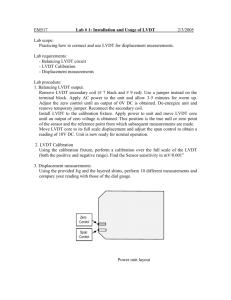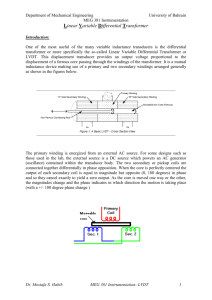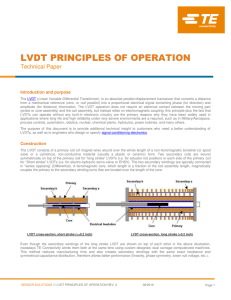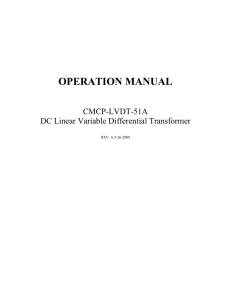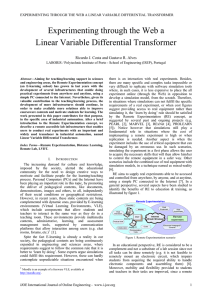LVDT: construction and principle of operation
advertisement
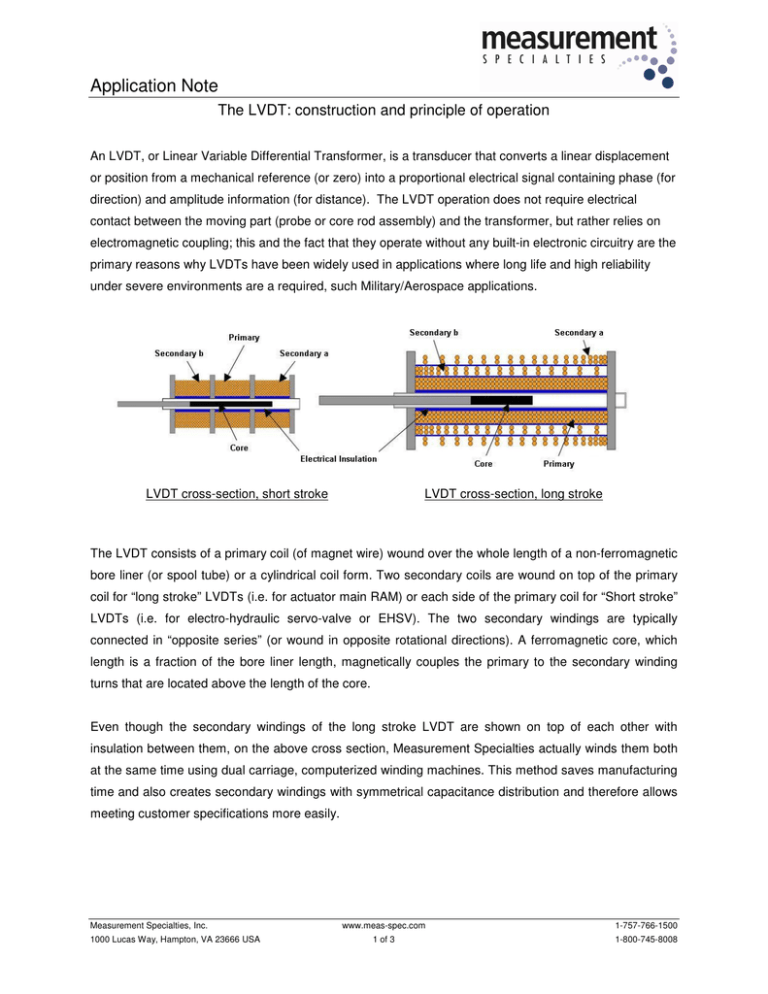
Application Note The LVDT: construction and principle of operation An LVDT, or Linear Variable Differential Transformer, is a transducer that converts a linear displacement or position from a mechanical reference (or zero) into a proportional electrical signal containing phase (for direction) and amplitude information (for distance). The LVDT operation does not require electrical contact between the moving part (probe or core rod assembly) and the transformer, but rather relies on electromagnetic coupling; this and the fact that they operate without any built-in electronic circuitry are the primary reasons why LVDTs have been widely used in applications where long life and high reliability under severe environments are a required, such Military/Aerospace applications. LVDT cross-section, short stroke LVDT cross-section, long stroke The LVDT consists of a primary coil (of magnet wire) wound over the whole length of a non-ferromagnetic bore liner (or spool tube) or a cylindrical coil form. Two secondary coils are wound on top of the primary coil for “long stroke” LVDTs (i.e. for actuator main RAM) or each side of the primary coil for “Short stroke” LVDTs (i.e. for electro-hydraulic servo-valve or EHSV). The two secondary windings are typically connected in “opposite series” (or wound in opposite rotational directions). A ferromagnetic core, which length is a fraction of the bore liner length, magnetically couples the primary to the secondary winding turns that are located above the length of the core. Even though the secondary windings of the long stroke LVDT are shown on top of each other with insulation between them, on the above cross section, Measurement Specialties actually winds them both at the same time using dual carriage, computerized winding machines. This method saves manufacturing time and also creates secondary windings with symmetrical capacitance distribution and therefore allows meeting customer specifications more easily. Measurement Specialties, Inc. 1000 Lucas Way, Hampton, VA 23666 USA www.meas-spec.com 1-757-766-1500 1 of 3 1-800-745-8008 Application Note The LVDT: construction and principle of operation LVDT Schematic When the primary coil is excited with a sine wave voltage (Vin), it generate a variable magnetic field which, concentrated by the core, induces the secondary voltages (also sine waves). While the secondary windings are designed so that the differential output voltage (Va-Vb) is proportional to the core position from null, the phase angle (close to 0 degree or close to 180 degrees depending of direction) determines the direction away from the mechanical zero. The zero is defined as the core position where the phase angle of the (Va-Vb) differential output is 90 degrees. The differential output between the two secondary outputs (Va-Vb) when the core is at the mechanical zero (or “Null Position”) is called the Null Voltage; as the phase angle at null position is 90 degrees, the Null Voltage is a “quadrature” voltage. This residual voltage is due to the complex nature of the LVDT electrical model, which includes the parasitic capacitances of the windings. This complex nature also explains why the phase angle of (Va-Vb) is not exactly 0 degree or 180 degrees when the core is away from the Null Position. Primary Excitation Differential output Va-Vb Direction 1: In-phase with excitation (0 degree) LVDT waveforms Differential output Va-Vb Direction 2: Out-of-phase with excitation (180 degree) Measurement Specialties, Inc. 1000 Lucas Way, Hampton, VA 23666 USA www.meas-spec.com 1-757-766-1500 2 of 3 1-800-745-8008 Application Note The LVDT: construction and principle of operation Temperature effects: While the temperature coefficient of sensitivity (output per unit of displacement) is determined by the number of winding turns, the resistance of the windings, the geometry of the armature, and the resistivity & permeability of the metals used in the LVDT construction, the null shift with temperature is solely affected by the expansion coefficients and lengths of the materials used in the construction of the transducer. “Ratiometric” operation: For the lowest temperature coefficient of sensitivity, the LVDT can be designed so that the sum of the secondary voltages (Va+Vb) remains constant over the displacement measuring range. By designing the signal conditioning electronic circuitry to measure the difference over sum ratio (Va-Vb)/(Va+Vb), one can see that the first order of the temperature coefficient of sensitivity is eliminated, as demonstrated below: Va(t)=Va(70F)*Ca Vb(t)=Vb(70F)*Cb The variable t is the temperature; 70F is the temperature reference (70 degrees F); Ca and Cb are the temperature coefficients of sensitivity. If Ca and Cb are assumed equal (first order approximation), then the ratio is independent of temperature: [Va(t)-Vb(t)]/[Va(t)+Vb(t)] = [Va(70F)-Vb(70F)]/[Va(70F)+Vb(70F)] Measurement Specialties, Inc. 1000 Lucas Way, Hampton, VA 23666 USA www.meas-spec.com 1-757-766-1500 3 of 3 1-800-745-8008

